| Relevant paintings: 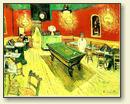
"Night Cafe on Place Lamartine in Arles," Vincent van Gogh
[Enlarge]
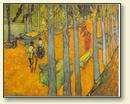
"Les Alyscamps: Falling Autumn Leaves," Vincent van Gogh
[Enlarge]
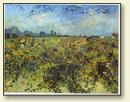
"The Green Vineyard," Vincent van Gogh
[Enlarge]
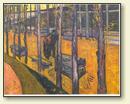
"Les Alyscamps," Vincent van Gogh
[Enlarge]
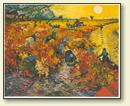
"The Red Vineyard," Vincent van Gogh
[Enlarge]
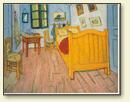
"Vincent's Bedroom in Arles," Vincent van Gogh
[Enlarge]
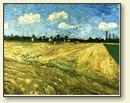
"Ploughed Field," Vincent van Gogh
[Enlarge]
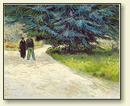
"Public Garden with Couple and Blue Fir Tree: The Poet's Garden III," Vincent van Gogh
[Enlarge]

"Vase with Twelve Sunflowers," Vincent van Gogh
[Enlarge]

"Portrait of Eugene Boch," Vincent van Gogh
[Enlarge]
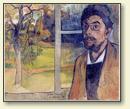
"Self portrait," Laval
[Enlarge]
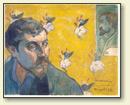
"Self portrait dedicated to Vincent van Gogh (Les Miserables)," Gauguin
[Enlarge]
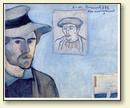
"Self portrait," Bernard
[Enlarge]
|
My dear Theo,
On the occasion of the first of May [Theo's birthday] I wish
you a tolerably good year, and above all good health.
How right Delacroix was, who lived on bread and wine alone,
and who succeeded in finding a way of life in keeping with his
vocation. But the inevitable question of money is ever-present
- Delacroix had private means. Corot too. And Millet - Millet
was a peasant and the son of a peasant.
You may perhaps be interested in reading this article I cut
out of a Marseilles paper because one catches a glimpse of
Monticelli in it, and I find the description of the painting
representing a corner of the churchyard very interesting. But
alas, it's yet another deplorable story.
How sad it is to think that a painter who succeeds, even if
only in part, pulls along half a dozen artists who are worse
failures than himself.
However, remember Pangloss, remember Bouvard et
Pécuchet - I do - and even that becomes clear
then. But perhaps those people don't know Pangloss, or else,
fatally marked by real despair and great suffering, they have
forgotten all they knew about him.
And anyway, we are falling back again in the name of
optimism on a religion that strikes me as the rear end of some
sort of Buddhism. No harm in that, on the contrary, if that's
what one wants.
I don't like the article on Monet in the Figaro very much -
how much better that other article in the 19me
Siécle was! One could see the pictures in that, and
this one is full of nothing but depressing banalities.
Today I am stuck in the middle of packing a case of pictures
and studies. I've stuck some newspapers on to one which is
flaking - it's one of the best, and I think that when you've
had a look at it you'll understand more clearly what my studio,
now come to grief, could have been. This study, just like some
of the others, was spoiled by the damp while I was ill.
The flood water came up to within a stone's throw of the
house, and more important, since the house wasn't heated during
my absence, by the time I got back water and saltpeter were
oozing from the walls.
In fact, we had several predecessors. Bruyas at Montpellier
gave a whole fortune to that, a whole life, and without the
slightest apparent result.
Yes - a chilly room in the municipal gallery where you can
see a troubled face and many fine pictures, where you certainly
feel moved, but, alas, moved as in a graveyard.
Yet it would be difficult to walk through a graveyard that
demonstrated more clearly the existence of that
Espérance which Puvis de Chavannes has
painted.
Pictures fade like flowers - even some of Delacroix's have
suffered in this way, the magnificent Daniel, Les odalisques
(quite different from those in the Louvre, it was in a single
range of purplish-blue), but how they impressed me, those
pictures fading there, little understood, that's for sure, by
most of the visitors who look at Courbet and Cabanel and Victor
Giraud, etc.
What are we, we other painters?
Oh, well, I'm sure Richepin is quite right, for instance
when he brutally bursts in and consigns them straight back to
the madhouse with his profanities.
However, I assure you that I know of no hospital where they
would be willing to take me in for nothing, even supposing that
I myself shouldered the painting expenses and left the whole of
my work to the hospital.
And that is, I don't say a great, but still a small
injustice. Even so, I should feel resigned if one took me in.
If I were without your friendship, they would drive me
remorselessly to suicide, and coward that I am, I should end by
committing it. At this point, I hope, we are permitted to
protest against society and to defend ourselves.
We can be fairly sure that the Marseilles artist who
committed suicide in no way did it under the influence of
absinthe, for the simple reason that no one is likely to have
offered him any and he could not have had anything to buy it
with. Besides, he would not have drunk it purely for pleasure,
but because, being ill already, he kept himself going with
it.
M. Salles has been to Saint-Rémy - they are not
willing to give me permission to paint outside the institution,
nor take me for less than 100 francs.
So this is pretty bad news.
If I could get out of this mess by joining the Foreign
Legion for 5 years, I think I should prefer that.
For on the one hand, being locked up and not working, I
should find it hard to get better, and on the other hand, they
would make us pay 100 francs a month during the whole long life
of a madman.
It's a bad business, and what are we to make of it? But
would they be willing to have me as a soldier?
I feel very tired after the conversation with M. Salles, and
I don't quite know what to do. I myself advised Bernard to do
his service there, so it's hardly surprising that I'm
considering going to Arabia as a soldier myself.
I say that so you will not blame me too much if I do go.
Everything else is so vague and so strange. And you know how
doubtful it is that one will ever get back what it costs to
paint. For the rest, it seems I am physically well.
Supposing I am only allowed to work under supervision! And
in the institution - my God, is it worth paying money for that?
In that case I could certainly work just as well, even better,
in the barracks.
Anyway, I'm thinking about it. You do so as well. Let us
remember that all is for the best in the best of all worlds -
it's not impossible.
A really good handshake,
Ever yours, Vincent
Here is what I think is worth putting on stretchers from the
consignment.
The packing case contains some studies by Gauguin which
belong to him, and his two fencing masks and some fencing
gloves.
If there is room in the packing case, I'll add some
stretchers.
At this time, Vincent was 36 year oldSource:
Vincent van Gogh. Letter to Theo van Gogh. Written 30 April 1889 in Arles. Translated by Mrs. Johanna van Gogh-Bonger, edited by Robert Harrison, number 588.
URL: https://www.webexhibits.org/vangogh/letter/19/588.htm.
This letter may be freely used, in accordance with the terms of this site.
|